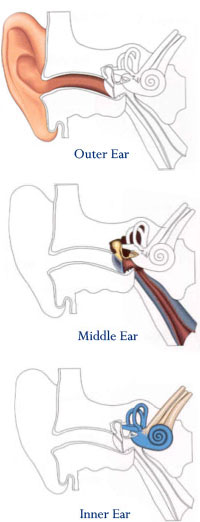- About Hearing
- Anatomy of the Ear
- Types of Hearing Loss
- Signs of Hearing Loss
- Hearing Conservation
Anatomy of the Ear
 The ear has three components: the outer, middle and inner ear...
The ear has three components: the outer, middle and inner ear...
Outer ear
The outer, or external ear is made up of the pinna or auricle and the external auditory canal. The pinna collects and funnels sounds down the “S” shaped ear canal, which is about 1 inch long in adults. It has hairs and wax-producing glands that help lubricate the skin and keep it moist.
Middle ear
The eardrum ortympanic membrane is a thin membrane found at the innermost part of the ear canal. Just beyond the tympanic membrane is an air-filled space called the middle ear cavity which houses a chain of three tiny bones, the malleus (hammer), incus (anvil) and stapes (stirrup).The first bone in the chain, the malleus, is connected to the eardrum so when a sound wave causes the eardrum to vibrate, all the bones vibrate. The last bone in the chain, the stapes, then transmits the vibrations to the inner ear as the footplate of the stapes vibrates in the oval window.
Inner ear
The inner ear has two divisions: one for hearing, the other for balance.
The hearing division consists of the cochlea and the nerve of hearing. The cochlea is a snail-shaped, bony structure that contains the sensory organ for hearing that releases chemical messengers when thevibrations from the stapesactivate its tiny hair cells. These excite the nerves of hearing which carry sound to the brain.
The second division, the one for balance, is made up of the semi-circular canals, and the utricle and saccule. The three semicircular canals are responsible for communicating messages to the brain about angular acceleration or head rotation while the utricle and saccule relay information about linear acceleration (up/down and forward/backward) Together, they provide the information the brain needs to maintain proper balance.


